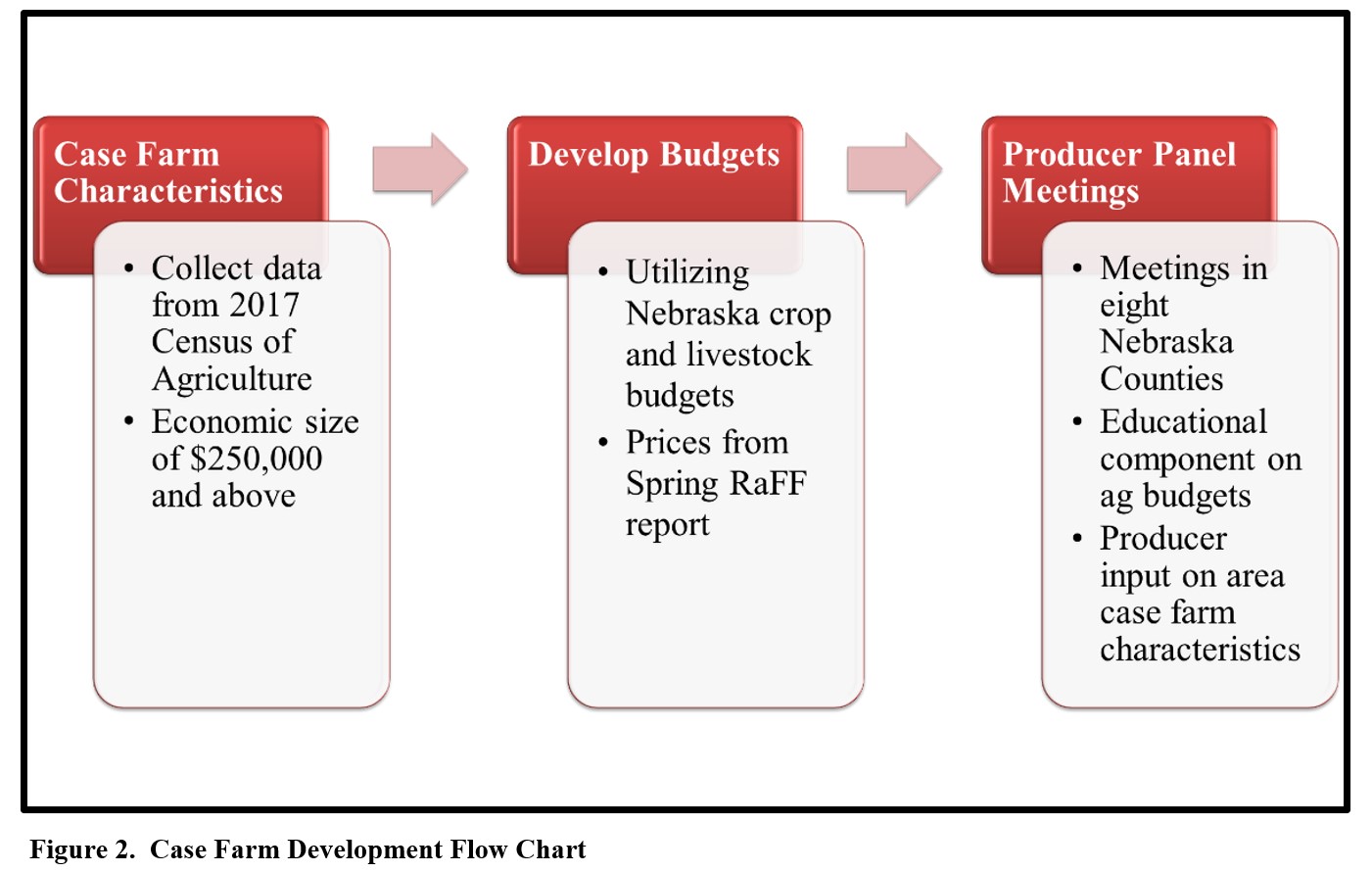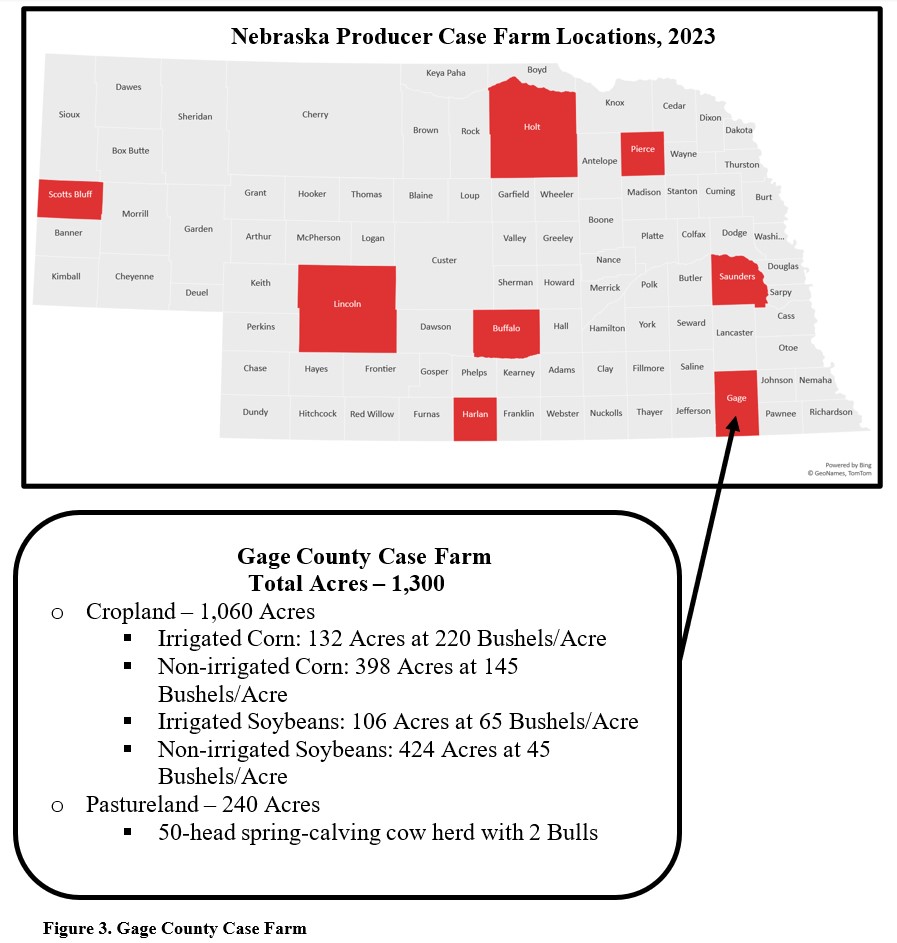Cornhusker Economics June 28, 2023
Utilizing Nebraska Case Farms to Analyze Farm-Level Income and Policy Changes
Agricultural producers, professionals, and policymakers often look to long-run projections for the agricultural industry as they make business and policy decisions. They can look to three different baseline projections that are produced by the United States Department of Agriculture, the Food & Agricultural Policy Research Institute (FAPRI), and the Congressional Budget Office (CBO). These baselines provide a 10-year outlook for the agricultural industry from prices and inventories for crops and livestock to international markets and income and expenditures. While this information provides insight into what direction agriculture may move, it can be hard to see the impact at the state and farm levels.
The Rural and Farm Finance Policy Analysis Center (RaFF) works with FAPRI to produce state-level income projections. The Center for Agricultural Profitability at the University of Nebraska-Lincoln collaborates with RaFF under the leadership of Dr. Bradley D. Lubben and Tatum R. Brunkow to produce state-level analysis for Nebraska. Figure 1 comes from the Spring 2023 Nebraska Farm Income Outlook (Maltsbarger, et al. 2023) and provides information as to the drivers of Nebraska’s net farm income changes between 2021 and 2023.

While state-level projections provide a closer outlook for Nebraska producers there can still be a disconnect between statewide numbers and farm-level results. Encompassing the diversity of Nebraska’s agriculture can be challenging as agricultural production practices can vary widely across the state. A series of case farms across the state can provide better insight into farm-level income and policy analysis and impacts. Eight counties that each lie in Nebraska’s eight agricultural statistics districts provide a geographical basis for case farms. Figure 2 lays out the process for case farm development. Data from the 2017 Agricultural Census, (NASS 2019) provides information to model a full-time farming operation for the selected counties, with an economic size of $250,000 and above. From there, acre and farm breakouts for the county are selected to determine what is representative of the area. With all the characteristics established for the case farm, Nebraska crop, and livestock budgets as well as the Agricultural Budget

Calculator (ABC) are then utilized to develop enterprise and whole-farm budgets. Prices from the 2023 Spring RaFF report are utilized in preparing the enterprise budgets. When case farms are completed, a panel of producers in each of the eight counties will help to synthesize the Census data with local knowledge to develop a case farm with the appropriate crop mix, acres, and livestock, if applicable that are representative of the area. Figure 3 shows the location of the eight case farm counties across Nebraska. The Gage County case farm was the first to be developed with local producer input. The Gage County case farm information highlighted in Figure 3 represents a typical operation in Gage County with a mix of irrigated and non-irrigated corn and soybeans and a 50-head cow-calf enterprise.

The development of all eight case farms will provide a basis for ongoing farm-level income and policy analysis. Figure 4 highlights the potential future uses of case farms. Using Monte Carlo simulation, stochastic, or random variables can be utilized to determine the probabilities of production and financial outcomes on case farms. Utilizing stochastic variables such as yields, prices, and input costs can then help model the probabilities of different outcomes on case farms. The simulations and analysis of the case farms provide the opportunity to educate producers and provide insight to make sound risk management decisions. Case farm information can be utilized as a risk management tool, not to tell producers what is to come, and what will happen, but to offer probabilities of what may happen depending on the stochastic variables being utilized.

Utilizing producer panel input from the eight locations across Nebraska provides another important opportunity to cross-check or re-affirm information provided in the Nebraska crop and livestock budgets based on geographic variables. The budgets are updated regularly through Nebraska Extension and the Center for Agricultural Profitability. An education component during the producer meetings helps inform participants on the use of the Agricultural Budget Calculator program and templates utilized in creating enterprise budgets.
The development of the case farms allows for the analysis of farms across the state that represent Nebraska’s agricultural diversity and show how changes in the economic outlook, changes in the farm safety net, or changes in production and management decisions may impact specific enterprises or whole operations. Ultimately, the case farms can provide researchers, producers, professionals, and policymakers the opportunity to extend national or state-level baseline projections all the way to the farm level to identify impacts and management decisions that can affect and improve farm viability.
References:
Congressional Budget Office. 2023. “The Budget and Economic Outlook: 2023 to 2033.” Prepared by the Congressional Budget Office. https://www.cbo.gov/publication/58946
FAPRI-MU. 2023. “U.S. Agricultural Market Outlook: March 2023 FAPRI-Mu Report #02-23.” Prepared by the FAPRI-MU Team. https://www.fapri.missouri.edu/publications/outlook/.
Maltsbarger, B., Lubben, B., Brunkow, T., Dennis, E,. McClure, G., Parsons, J., Thompson, E., Van Tassell, L. & C. Walters. March 2023. Spring 2023 Nebraska Farm Income Outlook. RaFF Report #01-2023. Available at: https://ruralandfarmfinance.com/publications/#state-farm-income-estimates
U.S. Department of Agriculture National Agricultural Statistics Service. 2019. 2017 Census of Agriculture: Nebraska State and County Data, Volume 1, Geographic Area Series, Part 27. Retrieved from https://www.nass.usda.gov/Publications/AgCensus/2017/Full_Report/Volume_1,_Chapter_1_State_Level/Nebraska/nev1.pdf.
USDA Office of the Chief Economist. 2023. “USDA Agricultural Projections to 2032.” Prepared by the Interagency Agricultural Projections Committee No. Long-term Projections Report OCE-2023-1, United States Department of Agriculture.
For more information:
The Center for Agricultural Profitability (CAP). https://cap.unl.edu/
- Agricultural Budget Calculator (ABC). https://agbudget.unl.edu/
- 2023 UNL Crop Budgets. https://cap.unl.edu/cropbudgets
- Cattle Budgets. https://cap.unl.edu/cattlebudgets
Rural and Farm Finance Policy Analysis Center (RaFF). https://ruralandfarmfinance.com/
Tatum R. Brunkow
Graduate Research Assistant
Department of Agricultural Economics
University of Nebraska-Lincoln
Bradley D. Lubben
Extension Associate Professor
Department of Agricultural Economics
University of Nebraska-Lincoln
blubben2@unl.edu
(402) 472-2235
Glennis McClure
Associate Extension Educator
Farm & Ranch Management Analyst
Department of Agriculture Economics
University of Nebraska-Lincoln
gmcclure3@unl.edu
402-472-0661